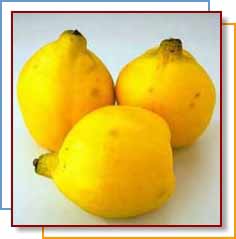
The quince is a relative of the apple and pear and belongs to the pome
fruit family. Quince is one of the earliest known fruits. For over 4,000
years, quince trees have grown in Asia and the Mediterranean. Today,
quince is also found in Latin America, the Middle East, and the United
States. The quince as we know it in the United States is a different fruit
from that found in Western Asia and tropical countries, where the fruit is
softer and more juicy. In colder climates, the fruit has a fine, handsome
shape, a rich golden color when ripe, and a strong fragrance, judged by
some to be heavy and overpowering.
|
|
Quince |
Serving size 1 quince (92g)
|
Amounts
Per Serving |
% Daily
Value |
| Calories
50 |
|
| Calories
from Fat 0 |
|
| Total Fat 0g |
0% |
| Saturated
Fat 0g |
0% |
| Sodium
0g |
0% |
| Total
Carbohydrate 14g |
5% |
|
Dietary Fiber 2g |
7% |
|
Sugars 12g |
|
| Protein
0g |
|
| Vitamin A |
0% |
| Vitamin C |
25% |
| Calcium |
2% |
| Iron |
4% |
Percent Daily Values are based on a
2,000 calorie diet. |
|
| |
|
In the raw form, the rind is rough and woolly, and the flesh is hard
and unpalatable, with an astringent, acidulous taste. In hotter countries,
the woolly rind disappears and the fruit can be eaten raw. Because it’s
rarely used in its raw form in the United States, the hard and dry flesh
of the quince turns light pink to purple, becoming softer and sweeter when
it’s cooked. Because of the astringent, tart flavor, quinces are commonly
made into preserves and jellies. When prepared as jelly, it tastes like a
cross between an apple and a pear. Sometimes the quince smells like a
tropical fruit.
Select fruit that are large, firm, and yellow with little or no green.
Quinces should be picked when full-yellow and firm. Quinces must be
handled carefully as they bruise easily.
Wrap quinces in a plastic bag and refrigerate them for up to 2 months.
Quinces are not eaten fresh because of their astringency (due to high
tannin content). Because of its high pectin content, it’s particularly
popular for use in jams, jellies, and preserves. Quinces tend to hold
their shape, so they are ideal for poaching, stewing, or baking as a
dessert.
This fragrant fruit is available September through January.
Recipes
 Quince Slices with Honey and Lime Quince Slices with Honey and Lime
Serves 4
Each serving equals 1/2 cup of fruit or vegetables
Ingredients
4 medium quinces, about 2 lbs
4 Tbsp honey
3 Tbsp lime juice
3 Tbsp water
Pre-heat oven to 300° F. Quarter and peel quinces. With a sharp knife,
remove the entire core area and all the hard parts surrounding the core.
Quarter the quince into 4 slices. Arrange slices overlapping in a baking
dish. Drizzle honey over slices to coat. Sprinkle with lime juice and
water, and cover with foil. Bake for 1 hour or until slices are soft and
translucent. Remove the foil and increase oven temperature to 425°F. Bake
for 10 minutes until syrup is slightly thickened and slices are golden.
Nutritional Analysis: Calories 120, Protein 0g, Fat 0g, Of Calories
From Fat 0%, Carbohydrates 32g, Cholesterol 0mg, Fiber 1 G, Sodium 5mg.
Find more in our
recipe database!
|



